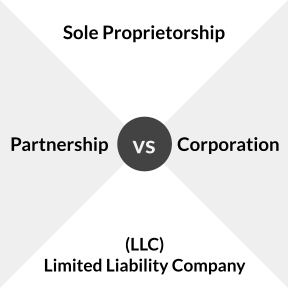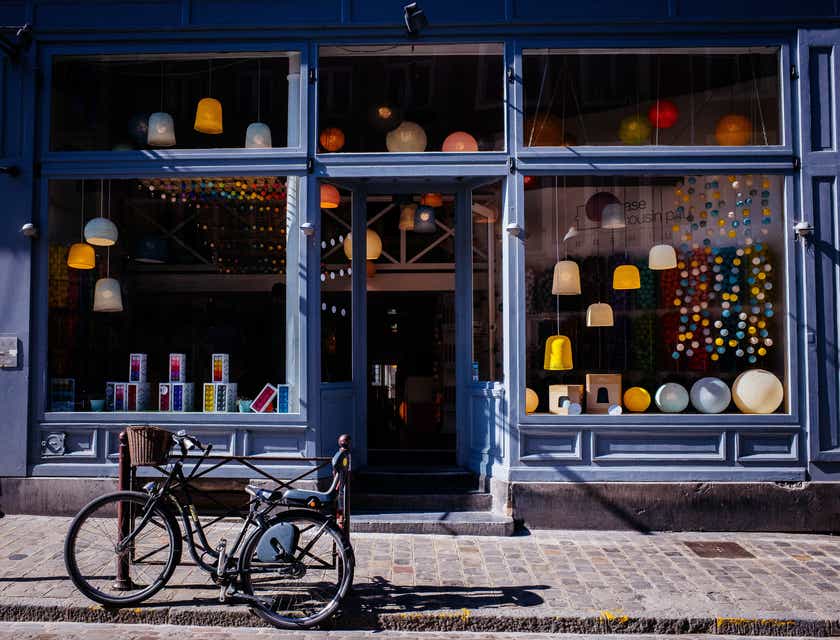
Enter your brand or company name to get started.

How to Open a Retail Store — Checklist
Download our free retail store checklist in PDF format.
Download NowThe retail industry employs 42 million workers across the U.S., with 98% of retail stores identifying as small businesses, providing excellent business potential.
How to Open a Retail Store:

A step-by-step outline for you to follow to go from an idea for a retail store to a grand opening.
Decide what type of retail store you would like to open.
Do market research.

Before you start planning your retail store, you should survey your potential consumers and perform economic studies. You should also study your competitors to determine what is working for them and what isn't, and analyze the demographics of your target market to ensure whatever retail store you start will suit your demographic.
Think about which products you would like to sell in your store.

Look at your market research to figure out which items your target market likes most and decide on which of these items you would like to sell.
Research the types of retail stores you could open.

Retail stores are sorted into categories based on the channels they use to sell to their customers. There are four distinct categories of retail:
Store retailers include department stores, convenience stores, national and regional chains, and conventional supermarkets, etc. Think Walmart or Target. These types of stores use prominent merchandise displays and signage to advertise their most popular products. They sell both household and business items.
Specialty retailers target niche markets and focus on specific product categories. They are considered product experts and sell a range of items within their product specialty, be it clothing, medical supplies, home decor, etc. Because they stock niche products, specialty retailers' inventory management is typically less cumbersome than most retailers.
Mail order retailers reach customers who are either unable to go shopping, live too far from a shop, or simply don't like the shopping experience. They send out informative catalogs and brochures advertising a broad range of products.
Online retailers cater to customers who want convenience in their shopping experience. Selling online means creating a shopping experience that is intuitive, reliable, and visually driven with detailed product descriptions and reviews. It should also have an easy ordering process and clear policies on warranties, returns, and refunds.
Create a business plan.
Write an executive summary.

Introduce your business to investors by describing what your business does, providing your mission statement, and explaining how your business stands out from other retail stores.
Define your company structure.

You will have to choose between being a sole proprietor, a corporation, or a Limited Liability Company (LLC). An LLC is the most common type of legal structure for retail stores. LLC taxes are reasonable and they protect personal assets in the event that you default on a loan or are sued.
Hire a lawyer or business consultant to help with the process.
Offer an extensive market analysis.

Describe your target market and discuss how you will promote your business. For example, you might use social media, newspaper advertisements, or signs outside your store to attract customers.
Detail your business offerings.

Describe the products you will sell in your retail store.
Describe your management plan and ownership structure.

Explain which roles you will fill, and who you may need to hire to perform core duties. For example, a store manager will be needed.
Outline your financial projections.

Calculate your revenue projections as well as your break-even point.
Download our free retail store business plan template for more information on which financial information to include.
Form your retail store company.
Trademark your business name.

Once you've chosen a suitable store name, run that name against the United States Patent and Trademark Office's (USPTO) trademark database to see if it's already in use.
Register as a legal entity.

Depending on the legal structure you will register, you can find the appropriate form on your Secretary of State website. Typically, you can file the application online with the requisite fee.
Purchase a domain name.

Purchase a domain name that matches your business name as closely as possible. You can purchase a domain through companies like Namecheap and GoDaddy.
Know all the licenses and permits that you need.

Business registration laws will differ from state to state. Retail store owners will need to check their local government websites to find out more about state laws and procedures they need to follow, and if the type of retail business they open requires any additional licenses. Find out more about obtaining a business license on sba.gov.
Apply for an Employer Identification Number (EIN).

LLCs, partnerships, C Corporations, and S Corporations are all required to obtain an EIN Number. You can apply for your EIN on the IRS website.
Trademark your intellectual property.

It's very important that you protect your intellectual property and not infringe upon others. We recommend consulting with a trademark attorney to oversee the process.
Obtain a Seller's Permit.

You may need a Seller's Permit when purchasing wholesale merchandise for resale.
Apply for a Resale Certificate.

A Resale Certificate allows you to buy items from distributors and resell them to your customers. Depending on the state you're operating from, you may need this certificate to avoid paying tax to the seller.
Open a business bank account.

This will make it easier to keep personal and business finances separate and makes your finances more legitimate.
Source funding.
Research funding options.

There are a few potential sources of funding:
Small business loan: You can approach banks and apply for a business loan.
Crowdfunding: Ask loved ones to contribute financially through a crowdfunding website or paid directly into your business bank account.
Business credit card: You can apply for a business credit card to cover day-to-day expenses.
Working Capital Loan: These loans are cash injections designed to help businesses experiencing short-term cash flow problems. These types of loans support a business's operational expenses during difficult periods.
Purchase equipment and software.
Research vendors.

To choose vendors you'll need to research their marketing support, return policy, credit terms, defective items, and payment terms before entering an agreement. Additional factors that determine a good vendor relationship is product quality and reliable delivery.
There are four types of vendors:
Manufacturers sell their products to retailers at wholesale and in large quantities. Contact them to find out if they sell directly to retailers or through distributors.
Importers bring in products from a different country to your country of operation. Retailers can buy directly from importers. Be sure to understand all the costs involved, paperwork, shipping times, and product life cycles.
Distributors act as a link between vendors and retailers in cases where reaching a vendor directly is too expensive.
Wholesalers and liquidators sell products that include closeouts, truckloads, and damaged goods.
Purchase essential equipment.

You will need to create a list of all the essential equipment needed to operate a retail store. The aim here is to find the right balance of quality and affordability.
Most retail stores will need:
- Cash register - $2000.00.
- Shelving and decor - $50.00–$100.00 per hour (for a contractor).
- POS system - $0–$79.00 /mo.
- Shopping bags - $0.05–$0.23 each.
- Shopping carts - $75.00–$150.00 each.
- Shopping baskets - $29.00–$57.00 each.
- Pricing and tagging gun - $19.00–$51.00 each.
- Labeler - $6.00–$343.00 each.
- "Wet floor" sign - $7.00–$57.00 each.
- "Open" and "closed" signs - $15.00–$48.00 each.
Purchase essential software.

Software that your business may need includes:
- An eCommerce site.
- Accounting software.
- Email marketing tools.
- An inventory management system.
- Payroll software.
Choose the right location.
Calculate gross to rent.

Ultimately, your budget will have the most say over the location of your store. Determine how much you are able to spend on monthly rent and choose a location that offers potential. To figure out what percentage of your sales should go towards paying your rent, use the following formula.
Annual cost of rent divided by gross annual income.
The standard gross-to-rent percentage falls between 1% and 13%. Anything below 10% is a healthy figure.
Focus on demographics.

Based on your customer research, you should have a good idea about who your target customers are and where they live, work or visit. It follows that you would select a location frequented by your target market.
Factor in your competition.

Find out how many similar stores operate in your area. Too much competition may mean you can't get enough customers, but competition can also be a good thing. A neighborhood with a strong retail presence creates a pedestrian culture. You can also benefit from your competitors' efforts to attract customers to the neighborhood.
Think about the visibility of a location.

Some retail stores struggle with inactivity because their store is not ideally located, while others prosper in the most unwelcoming areas because they offer a great product. While your location and level of service can greatly impact your store, the general rule is to offer both.
Bear in mind that visibility is positively correlated with rent, so areas that are easily accessible with a steady flow of pedestrians are likely to cost more.
Think about foot traffic.

Opening up in an area with a strong pedestrian culture can do wonders for your store. An area frequented by people on foot will make a chance visit to your store more likely.
Look out for parking availability.

Uber may have made getting around an easier task, but for patrons who prefer their own transport, parking is essential. If they have to walk far from a parking spot to your store, they may just consider someplace else.
Look up crime statistics.

If your neighborhood has a reputation for criminal activity, it may deter customers from coming to your store. Check local crime statistics before setting up shop.
Set up your retail store.
Design a layout.

Your store experience is part of your attraction to potential customers. But beyond branding and signage, the layout and design of your store are influential in determining a purchasing decision.
Ensure that all products are visible.

Use signs, staircases, and strategic product positioning to organize your store and guide customers into different store locations or sections.
Place profitable products in populated areas.

Ensure that the most profitable products or departments are placed in the most populated sections of the store.
Protect your products from theft.

Install cameras, keep expensive items under lock, and use mirrors to eliminate blind spots.
Buy store furniture that is mobile.

This makes it easier to change the store design without too much hassle. Avoid fixed furniture.
Place similar products near each other.

Place similar products and departments next to or close by each other. Cosmetics and clothing attract similar customers.
Hire staff.
Determine which staff members are needed.

Think about who needs to be employed. Most retail stores will need:
- A cashier.
- A manager.
- Store assistants.
- Cleaning staff.
Write job descriptions.

Once you know which staff members need to be hired, you can write a job description for each role. You should outline the day-to-day responsibilities and what experience is needed.
Post your job vacancies.

You can post your job description on an online job board or advertise in a newspaper. It may also be a good idea to post in social media groups that are relevant to job-seekers in your industry.
Interview candidates.

Interview candidates that meet your requirements. Do some research ahead of time to find relevant interview questions that test the candidate's suitability.
Hire suitable candidates.

Based on your interviews, hire applicants who are suitable for each role. Have a lawyer draw up employment contracts to protect all parties.
Ensure that you provide employee benefits.

Benefits that are standard for employees include:
- Social Security taxes.
- Workers’ Compensation.
- Disability insurance.
- Leave benefits.
- Unemployment insurance.
Promote your retail store.
Use social media.

Where you buy media will depend on where your customers are. If they use Facebook and other social media platforms, it could benefit you to run targeted campaigns to reach them.
Create Facebook, Instagram, and Twitter pages. Make the design aesthetic match that of your store. Be sure to include high-quality pictures on your page, especially on the visually-driven Instagram. Clothing retailers could benefit the most from modeling their apparel on Instagram. Use these platforms to advertise specials, run promotions, and get customer reviews and feedback for your store.
Create your own hashtag and encourage customers to use it when posting. This is a great way for potential customers to find out about sales and promotions.
Use influencer marketing. Influencer marketing tends to hold more weight than traditional advertising since people assign a level of trust and familiarity with influencers, making it easier to recommend a product or service.
Use referral campaigns to incentivize your customers to spread the word to their friends. Whenever a sale is made by clicking on a shared link, the customer who shared the link gets a discount on their next purchase as a reward.
Use search engine marketing (SEM).

When customers in your area search Google for a hardware store, for instance, they are likely to use search terms such as "hardware store near me." If you want customers to find you, you need to be at or near the top of search results. Search Engine Marketing (SEM) helps you rank in Google search results.
SEM is a highly technical field, so you may want to partner with a marketing agency.
Host a grand opening.

When you open your store, you can offer promotions such as discounts to attract customers.

Retail Store Business Plan — Free Template
Download our free retail store business plan template in MS Word format.
Download NowPrices for Essential Retail Store Items:
Items | Cost |
|---|---|
Signage | $165.00–$710.00 |
Shelving and decor | $50.00–$100.00 per hour (for contractor) |
POS system | $0–$79.00 /mo. |
Shopping bags | $0.05–$0.23 each |
Shopping carts | $75.00–$150.00 each |
Shopping baskets | $29.00–$57.00 each |
Security system | $79.00–$2,699.00 |
Pricing and tagging gun | $19.00–$51.00 each |
Labeler | $6.00–$343.00 each |
Box cutter | $6.00–$9.00 each |
Tape gun | $17.00–$28.00 each |
"Wet floor" sign | $7.00–$57.00 each |
Cleaning supplies | $500.00–$1,000.00 |
"Open" and "closed" signs | $15.00–$48.00 each |

Retail Inventory Estimation - Free Download
This Excel sheet contains all of the formulas to estimate inventory for your retail business.
Download NowUnderstanding Inventory: Key Formulas and Metrics
There are a number of key inventory metrics that can help increase the profitability of your retail store. Inventory, when not carefully managed, can lead to a loss of profits. The following formulas and calculations will help you optimize your inventory management to prevent that from happening.
Average Inventory at Cost is the cost value of the inventory that you keep for a given period (typically a year). If your average inventory is higher than your sales, you will incur excessive inventory costs and be forced to sell at markdown prices.
Average Inventory at Cost: The sum of end-of-month inventory for 12 consecutive months, divided by 12.
Turnover Rate is the number of times in a year your total inventory is sold or the average number of months it takes for your inventory to be sold. A high turnover rate means you need to spend less to generate the same sales.
Turnover Rate: Cost of goods sold for the year, divided by average inventory at cost.
Gross Margin Return on Investment tells you how much of gross profit dollars you receive for every dollar invested in inventory. If your value is 1.5, it means that for every dollar you invest in inventory, you get $1.50 in gross profits back. Anything below 2 is excellent, while a value below 1 is considered poor.
Gross Margin Return on Investment: Annual gross profit dollars divided by average inventory at cost.
The Open-to-Buy formula tells you how much inventory you can buy each month so that you can sell and not be overstocked, according to a specific turnover rate. It comes in two parts:
Open-to-Buy (Planning) formula: Planned sales in cost dollars, plus desired ending inventory, minus beginning inventory, minus open orders.
Open-to-Buy (Monitoring) formula: Beginning-of-month inventory at cost, plus month-to-date inventory receipts at cost, plus balance on order for the month at cost, minus month-to-date sales at cost, minus balance of month’s sales plan at cost.
The Weeks of Supply calculation tells you how many weeks it will take to completely sell all your stock of certain merchandise. The formula relies on current on-hand inventory and projected sales per week.
Weeks of Supply: Current on-hand, divided by projected weekly sales.
Typical Costs for a Retail Store:
Items | Cost |
|---|---|
Business entity formation | $300.00 |
Location improvement costs | $7,650.00 |
Technology | $6,165.00 |
Store design | $8,900.00 |
Licensing and permits | $2,000.00 |
Annual insurance coverage | $2,000.00 |
Working with an attorney | $400.00 per hour |
Printing, promotion, and online marketing | $1,500.00 |
Rent | $15.59 per square meter (Albuquerque, NM) – $3,400.00 per square foot (New York City, NY) |
Average electricity per square foot | $1.47 |
Annual workers’ compensation | $1,400.00 |
How to Apply for an EIN Online






